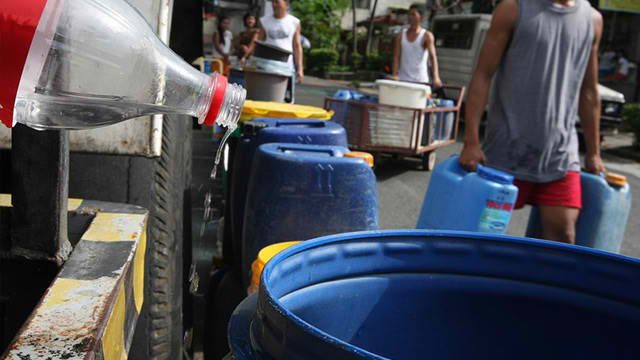SUMMARY
This is AI generated summarization, which may have errors. For context, always refer to the full article.

MANILA, Philippines – An estimated 355,500 households in Metro Manila may experience water interruption starting the week of September 7, the National Water Resources Board (NWRB) said.
These households may experience less than 12 hours of water supply every day starting next week if critical dams like Angat Dam, Ipo Dam, and La Mesa Dam are not replenished by rain this week and the coming months.
The projected water shortage may last from September to February 2016 due to the El Niño phenomenon currently affecting the Philippines, said the agency in a press briefing on Tuesday, September 1.
The 355,500 households are customers of major water concessionaires Manila Water and Maynilad.
According to company representatives, 18% (230,000) of households serviced by Maynilad and 9% (125,500) of households serviced by Manila Water will experience water disruption.
The water disruption is due to the lower water allocation given to the two concessionaires by the NWRB, in order to conserve water from major dams.
The NWRB’s move is in preparation for even drier days ahead, especially during the dry months of December to February next year, and the summer months.
The water level in Angat Dam is already at 186.24 meters – 23.76 meters below the normal level of 210 meters.
The adjusted water allocation for September is 38 cubic meters per second (cm/s), said NWRB Executive Director Sevillo David.
This is lower than the normal allocation of 41 cm/s.
“Because of stronger El Niño, we are preparing a schedule of allocation which is still subject to modification depending on the weather,” added David.
Because of the lower water allocation, the 355,500 households may have to experience more than 12 hours a day without water supply.
The rest of Metro Manila households may experience reduced water pressure or weaker water flow, said MWSS Senior Deputy Administrator Nathaniel Santos.
The homes that may experience more than 12 hours a day without water are in the following areas:
Maynilad:
- North Caloocan
- Quezon City
- Parañaque
- Cavite
- Valenzuela
Manila Water:
- Quezon City
- Antipolo
- Rodriguez
- Taguig
- Pasig
- Marikina
Best efforts
These areas are likely to experience the brunt of water disruptions because they are in higher-elevated parts of the metro or are far from concessions of the water companies.
Officials gave assurances they would do their best to manage the water shortage.
“We are doing all efforts so the inconvenience is less. During the 2010 El Niño, many customers of Maynilad experienced no water for 24 hours. This time around, that is what we are avoiding – for any one customer to have no water for an entire day,” said Maynilad head of Water Supply Operations Ronaldo Padua.
If the dams do not experience rain this week, the water disruption may begin as early as Tuesday, September 8, for Maynilad customers and Thursday, September 10 for Manila Water customers.
Manila Water Media Relations Manager Dittie Galang said both companies will inform the specific households and villages affected at least a day before the water disruption so residents can begin storing water.
A list of affected villages will be posted on their websites and social media platforms like Facebook and Twitter, she added. Affected households will also be informed through inserts in their billing statements.
Help farmers, conserve water
Based on projections of the NWRB, water disruptions will continue and even intensify. (READ: El Niño could be strongest in modern history)
If the September allocation is 38 cm/s, the tentative October allocation is 37 cm/s and November, 36 cm/s.
The lowest tentative water allocation is for February and March – only 34 cm/s.
The NWRB and the water concessionaires said they have yet to announce how lower water allocations will impact water disruption. For instance, will the lower allocations mean even more hours a day, and homes, without water?
Despite the inconvenience to households, the sector most affected by the water shortage are the farmers of Bulacan and Pampanga.
Whenever dams reach below-normal levels, water supply for irrigation of rice paddies is cut off in order to prioritize Metro Manila households.
Thus, out of the 23 hectares of rice fields, only 13 hectares were planted with rice seedlings for the cropping season of June to October, said National Irrigation Administration (NIA) Operations Department Manager Romeo Lopez.
This reduced the incomes of around 19,700 farmers and subtracted 50,000 metric tons of rice from total production.
Because the drought is expected to worsen, the NIA expects that the entire 26 hectares of planting area for November to April 2016 will not be planted with rice. This will mean a loss of 130,000 metric tons of rice.
Because of the hardships to be endured by farmers just to ensure water supply to Metro Manila, the NWRB appealed to households to conserve water.
Homeowners are asked to refrain from washing their cars or watering their gardens, or to collect rainwater for such chores. Households can also make sure their water pipes are not leaking.
In terms of government action, the NWRB also recommended the creation of an El Niño task force for Metro Manila and the conduct of cloud-seeding operations to induce rain. – Rappler.com
Add a comment
How does this make you feel?
There are no comments yet. Add your comment to start the conversation.